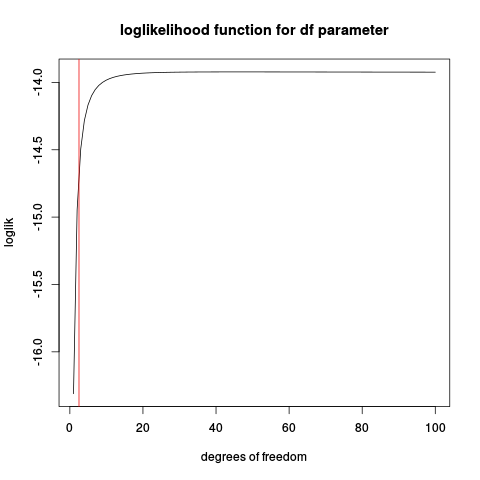MASS, the book (4th edition, page 110) advices against trying to estimate $\nu$, the degrees of freedom parameter in the t distribution with maximum likelihood (with some literature references I will add in here when I have the book with me).
The reason is that the likelihood function for $\nu$ based on the t density function, may be unbounded! and will in those cases not give a well defined maximum. Let us see at an artificial example where location and scale is known (as the standard $t$-distribution) and only the degrees of freedom is unknown. Below is some R code, simulating some data, defining the loglikelihood function and plotting it:
set.seed(1234)
n <- 10
x <- rt(n, df=2.5)
make_loglik <- function(x)
Vectorize( function(nu) sum(dt(x, df=nu, log=TRUE)) )
loglik <- make_loglik(x)
plot(loglik, from=1, to=100, main="loglikelihood function for df parameter", xlab="degrees of freedom")
abline(v=2.5, col="red2")
If you play around with this code, you can find some cases where there is a well-defined maximum, especially with the sample size $n$ large. But is the maximum likelihood estimator then any good?
Let us try some simulations:
t_nu_mle <- function(x) {
loglik <- make_loglik(x)
res <- optimize(loglik, interval=c(0.01, 200), maximum=TRUE)$maximum
res
}
nus <- replicate(1000, {x <- rt(10, df=2.5)
t_nu_mle(x) }, simplify=TRUE)
> mean(nus)
[1] 45.20767
> sd(nus)
[1] 78.77813
Showing the estimation is very unstable (looking at the histogram, a sizeable portion of the estimated values is at the upper limit given to optimize of 200).
Repeating with a larger sample size:
nus <- replicate(1000, {x <- rt(50, df=2.5)
t_nu_mle(x) }, simplify=TRUE)
> mean(nus)
[1] 4.342724
> sd(nus)
[1] 14.40137
which is much better, but the mean is stil way above the true value of 2.5.
Then remember that this is a simplified version of the real problem when location and scale parameters also have to be estimated.
If the reason of using the $t$-distribution is to "robustify", then estimating $\nu$ from the data well may destroy the robustness.

